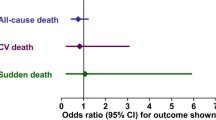Summary
Several so-called multiple-action compounds have been developed, such as medroxalol (alpha and beta blockade, and beta-2 stimulation), celiprolol (alpha-2 and beta-1 blockade, and beta-2 stimulation) and carvedilol (beta blockade and vasodilatation) for the treatment of patients with arterial hypertension and with coronary heart disease. Carvedilol exerts relatively uniform peripheral effects, i. e. a reduction of both systolic and diastolic blood pressure at rest and during exercise, and a decrease in the resting and exercise heart rate. Blood pressure fall due to carvedilol may be induced by its vasodilating effect, as documented by measurements of forearm blood flow and peripheral vascular resistance. Moreover, renal hemodynamics does not seem to be significantly altered by carvedilol. Carvedilol may also produce an improvement of the LV contractile status in patients with CHD and impaired LV function, mainly due to afterload reduction, in addition to its antianginal effect, which is due mainly to the beta-blocking properties of this substance. From the studies mentioned it may be concluded that carvedilol is a useful and promising drug for treating patients with both arterial hypertension and with coronary artery disease.
Similar content being viewed by others
References
Abshagen U (1987) A new molecule with vasodilating and β-adrenoceptor blocking properties. J Cardiovasc Pharmacol 10 [Suppl 11]: S23-S32
Tomlinson B, Cronin CJ, Graham BR, Prichard BNC (1987) Hemodynamcs of carvedilol in normal subjects compared with propranolol, pindolol and labetalol. J Cardiovasc Pharmacol 10 [Suppl 11]: S69-S75
Sundberg S, Tiihonen K, Gordin A (1987) Vasodilatory effects of carvedilol and pindolol. J Cardiovasc Pharmacology 10 [Suppl 11]: S76-S80
Leonetti G, Sampieri L, Cuspidi C, Boselli L, Terzoli L, Rupoli L, Zanchetti A (1987) Resting and postexercise hemodynamic effects of carvedilol, a β-adrenergic blocker and precapillary vasodilator in hypertensive patients. J Cardiovasc Pharmacol 10 [Suppl]: S94-S96
Heber ME, Brigden GS, Caruana MP, Lahiri A, Raftery EB (1987) Carvedilol for systemic hypertension. J Cardiovasc Pharmacol 10 [Suppl 11]: S113-S118
Meyer-Sabellek W, Schulte K-L, Distler A, Gotzen R (1987) Circadian antihypertensive profile of carvedilol (BM 14190). J Cardiovasc Pharmacol 10 [Suppl 11]: S119-S123
Morgan T, Snowden R, Butcher L (1987) Effect of carvedilol and metoprolol on blood pressure, blood flow and vascular resistance. J Cardiovasc Pharmacol 10 [Suppl 11]: S124-S129
DuPont AG, Niepen P van der, Taeymans Y, Ingels M, Piepsz A, Bossuyt AM, Block P, Six RO, Jonckheer MH, Vanhaelst L (1987) Effect of carvedilol on ambulatory blood pressure, renal hemodynamics and cardiac function in essential hypertension. J Cardiovasc Pharmacol 10 [Suppl 11]: S130-S136
Eggertsen R, Sivertsson R, Andren L, Hansson L (1984) Hemodynamic effects of carvedilol, a new beta-adrenoceptor blocker and precapillary vasodilator in essential hypertension. J Hypertension 2: 529–534
Prichard BNC, Tomlinson B (1989) Clinical pharmacology of
Wendt T, Does R van der, Schräder R, Landgraf H, Kober G (1987) Acute hemodynamic effects of the vasodilating and β-blocking agent carvedilol in comparison to propranolol. J Cardiovasc Pharmacology 10 [Suppl 11]: S147-S150
Lahiri A, Rodrigues EA, Dasgupta P, Jain D, Does R van der, Raftery EB (1989) Effects of carvedilol in patients with impaired left ventricular function due to ischemic heart disease. Z Kardiol [Suppl 3] 78: 21–27
Höher M, Friedrich M, Sommer T, Marten A, Ehmer B, Hombach V, Hirche HJ (1989) Effects of carvedilol on left ventricular function and arrhythmias during repeated short-time myocardial ischemia in experimental pigs. Z Kardiol [Suppl 3] 78: 7–15
Author information
Authors and Affiliations
Rights and permissions
About this article
Cite this article
Hombach, V., Kochs, M., Höher, M. et al. Hemodynamic profile of carvedilol. Eur J Clin Pharmacol 38 (Suppl 2), S101–S103 (1990). https://doi.org/10.1007/BF01409474
Issue Date:
DOI: https://doi.org/10.1007/BF01409474




